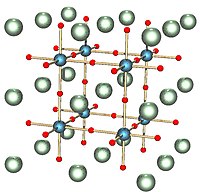
Photo from wikipedia
We report on a detailed investigation of the crystal structure and transport properties in a broad temperature range (2-723 K) of the homologous compounds (PbSe)5(Bi2Se3)3m for m = 2, 3.… Click to show full abstract
We report on a detailed investigation of the crystal structure and transport properties in a broad temperature range (2-723 K) of the homologous compounds (PbSe)5(Bi2Se3)3m for m = 2, 3. Single-crystal X-ray diffraction data indicate that the m = 2, 3 compounds crystallize in the monoclinic space groups C2/m (No. 12) and P21/m (No. 11), respectively. In agreement with diffraction data, high-resolution transmission electron microscopy analyses carried out on single crystals show that the three-dimensional crystal structures are built from alternating Pb-Se and m Bi-Se layers stacked along the a axis in both compounds. Scanning electron microcopy and electron-probe microanalyses reveal deviations from the nominal stoichiometry, suggesting a domain of existence in the pseudo binary phase diagram at 873 K. The complex atomic-scale structures of these compounds lead to very low lattice thermal conductivities κL that approach the glassy limit at high temperatures. A comparison of the κL values across this series unveiled an unexpected increase with increasing m from m = 1 to m = 3, in contrast to the expectation that increasing the structural complexity should tend to lower the thermal transport. This result points to a decisive role played by the Pb-Se/Bi-Se interfaces in limiting κL in this series. Both compounds behave as heavily doped n-type semiconductors with relatively low electrical resistivity and thermopower values. As a result, moderate peak ZT values of 0.25 and 0.20 at 700 K were achieved in the m = 2, 3 compounds, respectively. The inherent poor ability of these structures to conduct heat suggests that these homologous compounds may show interesting thermoelectric properties when properly optimized by extrinsic dopants.
Journal Title: Inorganic chemistry
Year Published: 2018
Link to full text (if available)
Share on Social Media: Sign Up to like & get
recommendations!